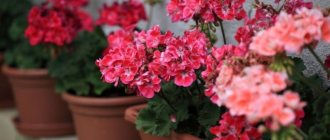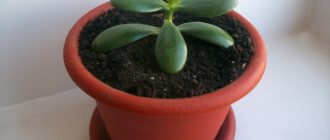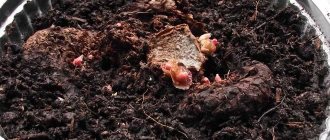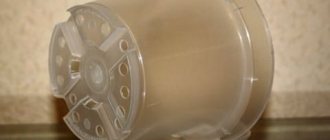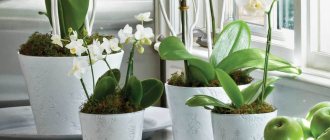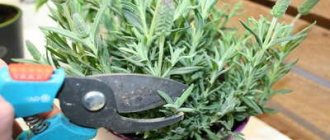Soil for fuchsia
For any plant, properly selected soil is the key to health, adequate nutrition, moisture and ventilation of the roots.
Fuchsias prefer light, nutritious soil with good drainage and a neutral or slightly acidic reaction.
Theoretically, almost any purchased universal soil is suitable, especially after adding sand. But in practice, its quality often leaves much to be desired: at best it will be pure peat, which shrinks too much when drying and quickly loses nutrients. At worst, you can get a lot of debris, and even weed seeds and spores of pathogenic fungi along with the substrate. Universal substrates from manufacturers “Rich Land” and “Compo San” are praised.
There are several options for homemade soil mixtures for fuchsias:
Sod is a cut of the top layer of soil (10 - 12 cm) from pastures, which has been rotted for 6 - 8 months. Due to the remnants of grass root fibers, which completely decompose after about 2 years, it does not caking and retains water. It can be loamy, less often sandy loam, it depends on the source material. Loamy soil is heavier, so when using it, you can increase the proportion of peat or leaf humus, and together with sandy loam, less sand and more fertilizers are used. Before use, it should be barely damp and easy to crumble.
Peat is a natural fossil, formed from dead plants under high humidity and lack of oxygen. It has a very high ability to absorb water, so if you bought it completely dried, moisten it a day before use. It’s better to buy granular – it gives the substrate structure and lightness. Use well moistened.
Leaf humus is leaves of trees rotted during the year, preferably oak or beech; the finished humus must pass through a garden sieve. Can be replaced with soil from under the appropriate trees, or, if not possible, with peat. It contains few nutrients, but improves the structure, breathability and moisture capacity of the soil.
Sand also improves soil structure, adds weight and creates a barrier for roots so they occupy the middle of the pot and not just circle around the perimeter. We strongly do not recommend fine quarry sand - it tends to cake into hard lumps when wet. The best choice is washed river coarse grain. Can be replaced with highly crushed clay shards.
Coconut soil is new to most gardeners. It is made from coconut shells, sold dry, pressed into briquettes, and when wet it swells greatly. It has a high moisture capacity and content of microelements, and decomposes for a very long time. Such soil is almost impossible to fill, and this is valuable for fuchsias. It can occupy up to 50% of the substrate; the rest can be supplemented with ordinary garden soil with the addition of sand or vermiculite.
Dry sphagnum moss is also added instead of peat or together with it (accounting for its share in the substrate) - it also ensures lightness and airiness of the soil.
In addition to these ingredients, fertilizers, vermiculite, pine needles, charcoal, ash, rotted manure (for fertilizer), hydrogel (a quarter of a teaspoon per medium pot, it is very moisture-absorbing) or crushed coconut fiber are added to the substrate.
2-3 cm of perlite, charcoal or other drainage is poured onto the bottom for drainage.
Methods for rooting cuttings
In order for the operation to be successful, it is necessary to create suitable conditions. Containers with cuttings should be placed in a bright, but without direct rays, place with high air humidity. Temperature – from 10 to 24° C.
In warm weather, the crop takes root faster, but gives a lot of attacks. The cold weather will delay the process for a month, but the plants will be healthy and almost all the cuttings will be accepted.
It makes no sense to use stimulants for fuchsia germination. The timing of the appearance of lower shoots in the branches treated with hormones and in control samples differs little.
In water
Rooting fuchsia cuttings in water is a way to save space and control the formation of lower shoots. The liquid is not changed until transplantation, but added as needed.
Settled, filtered, boiled, melt water is suitable. An activated charcoal tablet or piece of charcoal is added to the container. Rooting in a stimulant solution is not practiced - the cuttings can be soaked in it for a day, then placed in clean water.
Fuchsia produces roots well in plastic or glass cups or transparent vials. But, if difficulties arise during propagation, sometimes it is enough to darken the container for rooting to be successful.
The cuttings are placed so that the lower internode is in water. Usually they are not covered with glass or cellophane - the humidity will be high from the evaporating liquid.
Blackening of the lower cut does not mean anything when the branch looks good. The alarm should only be sounded if the leaves of a shoot standing in water wither. You need to renew the cut and soak it completely in a solution of epin or zircon for several hours. When the turgor is restored, return it to a washed container with clean fresh water.
Roots may appear in a few days or 1-2 weeks. This depends on many factors, including external conditions, variety, degree of woodiness or size of cuttings.
They are transplanted into light fuchsia soil when the length of the roots is from a few millimeters to 2 cm, no more. This makes them less likely to break.
In the substrate
The advantage over germinating roots in water is that when transplanting, the lower shoots break less. And if you propagate fuchsia immediately in light soil with baking powder, and transfer it with a lump, the roots will not be injured at all.
Green or semi-lignified cuttings
Fill with substrate, lightly squeeze, water with warm water:
- small pots;
- plastic cups with pre-drilled bottom holes;
- general containers are wide and low.
When planting in a pot or other container, not only the lower internode is buried, but the cutting is planted as deep as possible - more roots will grow. It is correct to do this at an angle, but so that the fuchsia does not touch the side. Branches planted directly also successfully produce roots, but a little later.
Vertical planting of fuchsia stimulates the growth of the top, at an angle of 45° - the roots.
Using a peg or other tool, make a hole in the substrate and insert a fuchsia cutting. Carefully moisten the soil to ensure good adhesion to the shoot - if this is not done immediately, a lunge is guaranteed. Cover with a glass cap, a transparent bag, and place in a mini-greenhouse.
When planting, fuchsia cuttings can be “tricked.” A little ready-made or sterile garden soil, literally a few millimeters, is poured onto the bottom of the container, and a barren substrate is placed on top. The roots will be drawn to the food source, the lower shoots will form and develop faster.
Pinched tops
The cuttings are tiny and require careful handling. They are not germinated in a barren substrate; they are immediately planted in light soil with baking powder. Wet the surface, preferably with a solution of Fitosporin. Place in a zip bag or mini-greenhouse and expose to light.
Until growth processes resume, they are no longer touched. Then they begin to carefully ventilate and accustom him to fresh air.
Planting cuttings remaining after the main pruning
Owners feel sorry for throwing away thick fuchsia branches, but they cannot be rooted in the usual way. It is necessary to cut the cuttings and immediately plant them in individual pots with a diameter of about 7 cm in light soil with baking powder. Infertile substrates are not suitable.
The containers are watered, placed in a tight transparent bag, and tied tightly. You can use large zip bags. Store in a dark, frost-free basement along with mature fuchsias.
In the spring, they take it out at the same time as the plants that are ready to awaken, change the bag, and expose it to the light. Soon the surviving fuchsia cuttings will show new leaves. If everything is done correctly, there will be few lunges.
Fertilizers and fertilizers
In order to correctly calculate the dose and understand what kind of feeding the plant needs, you now need to be a professional.
Moreover, if you have already applied liquid fertilizers, the plant is forced to absorb them, even if it is harmful. Therefore, it is better to add balanced nutrition to the substrate - it should be enough for a year, or even two, until the next transplant. You can prepare such a dry fertilizer mixture yourself. To do this, for 24 liters of substrate take:
Mix all ingredients separately from the substrate, add before planting: in the indicated doses (6g of mixture per liter of substrate) - for rooted young plants (pot diameter - 10 - 15 cm), for juveniles - reduce the dosage by 2 times, and for large plants - increase 1.5 times.
When applying any fertilizers (either these or liquid ones), remember that they oxidize the soil, which must be neutralized with lime, or better yet, with seaweed petrified to the state of limestone, at the rate of 1 - 1.5 g per 1 g of fertilizer.
With this scheme for enriching a properly composed substrate, liquid fertilizing will be required only for adult plants that no longer change the pot.
Alternative fertilizer options include river silt (rich in nitrogen and microelements, can replace horn and hoof meal) or dry fish fertilizer (40 ml per 7 liters of substrate for adult plants).
Source
Reproduction and transplantation
If you plan to propagate a plant by seeds, you should first protect the unopened bud from self-pollination and pollination by insects.
- Specks of dust from the bud must be removed in advance, and the bud itself must be covered with a cover of paper or fabric.
- When the flower is ripe, the seeds must be carefully collected and sown in accordance with the procedure indicated in the previous paragraph.
The vegetative propagation method can be used at any time of the year, but experienced breeders recommend doing it in the spring. Observe the following rules:
- for propagation you need to choose a young cutting from 10 to 20 cm long;
- remove the leaves at the bottom of the cuttings, cut the rest by half;
- place the cuttings in filtered water;
- Cover the top of the cutting with film or a bag, you can use a bottle.
You can expect the first roots to appear in 4-5 days , but in some cases you have to wait about 2 weeks. When they appear, you need to immediately plant the cuttings in the substrate.
Read more about how to propagate fuchsia from leaves here, and from this article you will learn how to properly transplant fuchsia and get abundant flowering.
Decorative fuchsia flower on your window! Photo, planting and care
Fuchsia is a perennial shrub native to South America. The indoor plant retains its need for high humidity and moderate temperatures. Abundant flowering continues from April to October.
Growing fuchsia at home requires compliance with the rules of agricultural technology. How to plant fuchsia, possible care problems - read on.
Choosing a place for a flower pot
When you bring a new plant home from a store or office, it is placed separately from other flowers. This is done to eliminate the risk of infection of indoor plants, because a lot of parasites can be brought in with the soil and on the leaves of the “newbie”. If bugs, worms or mites are found in the soil, they are treated with fungicides and insecticides.
The popular bookmaker has released a mobile application for Android, you can follow the link absolutely free.
Advice! After treatment, put a plastic bag on the bush. The shelter is removed after a day, during which time the parasites will die.
The permanent place for the flower should be well lit, but without direct sunlight. The pot is placed on the windowsills of western and eastern windows. Before placing it in a permanent place, the bush is placed in a good pot and sprayed. Fertilizers and minerals are applied no earlier than 14-20 days after transshipment.
How to plant at home?
A purchased plant or a cut cutting of a fuchsia flower will take root and begin to grow if the planting and care rules are followed. The health of the plant depends on the selected soil and maintenance conditions.
Which pot to choose?
Every year, when replanting, the size of the pot increases by 2-3 cm. The root system of the flower should completely entwine the earthen ball. Free soil turns sour, causing roots to rot.
Recommended material: ceramics, light color. Such a pot will not overheat in the sun. In dark plastic, the roots of the plant die under the influence of high temperature. There should be drainage holes at the bottom of the container.
Soil composition
Fuchsia requires a nutritious loose substrate with neutral acidity. A ready-made universal mixture for flowering plants is recommended.
To improve the structure, leavening agents are added to the soil - perlite, vermiculite, coconut substrate. If desired, prepare the soil yourself:
A drainage layer of expanded clay or small pebbles is poured onto the bottom of the pot. It will prevent water stagnation and soil erosion.
What should I do to get the shoot to take root?
The fuchsia shoot is rooted in soil or water. In order for the cutting to grow roots, it is required:
Covering with a glass jar or bag will ensure the required level of humidity. The shoot is ventilated daily and condensation is removed from the walls of the jar. The seedling is sprayed with water at room temperature. The appearance of new leaves after 2-3 weeks indicates successful rooting.
Location and lighting
A fuchsia pot is placed on east or west windows. On the north side it provokes weak flowering. The plant needs diffused lighting and fresh air. The best place for flowers is the balcony. During the flowering period, fuchsia cannot be touched or rearranged; it immediately drops its buds.
Temperature
Fuchsia tolerates cool temperatures well, but heat causes lethargy and drooping leaves. The optimal temperature during the growing season is 16-20°, in winter 10-11°. In summer, the flower is removed away from direct sunlight, which causes burns to the leaves and overheating of the roots.
Watering
Moistening the flower is the most important part of agricultural technology. Lack of water leads to drying out, and overwatering leads to rotting of the roots. Watering is carried out with settled water.
The volume and frequency of humidification depend on the temperature in the room, the volume of the pot, and the stage of development. The average is 100 ml per 0.5 liter pot, every 3-4 days. A little trick will help you determine the need for watering. A wooden stick is stuck at the edge of the pot; if it is wet and dirty, then it’s not time yet. If there are lumps of earth on the stick, it's time to moisturize.
Watering is partially replaced by spraying. While there are no flowers, the plant is periodically placed under the shower. In autumn, the amount of water is reduced. In winter, 1-2 waterings per month are sufficient.
Fertilizers
Fuchsia is a plant that requires regular feeding. A young flower needs fertilizer with a high nitrogen content. An adult plant requires complete feeding with phosphorus, calcium and other microelements. Applying complex fertilizers once a week will satisfy the needs of fuchsia. Foliar feeding with the drug "Bud" is effective during the flowering period. Mineral products alternate with organic ones.
The use of long-acting fertilizers Osmocote gives good results. The drug is buried in the soil above the drainage layer. Minerals are in capsules that gradually dissolve when watered. In the spring, to stimulate shoot growth, they are sprayed with magnesium sulfate (1 tsp per 1 liter of water).
Fertilizers can be applied daily with watering, reducing the recommended concentration by 6 times.
It is prohibited to feed:
Below you can see photos of fuchsia flowers:
Features of fuchsia care
Fuchsia lighting
Fuchsia feels best when the light is diffused, but it can also bloom when grown in shaded areas (north-facing windows). Many reference books say that when growing fuchsia on south-facing windowsills, it is better to shade the plant during the day. I may not agree with this. My fuchsias grow in full sun and thrive. Only the leaves “tan” from direct sun and become reddish.
Content temperature
Since the homeland of fuchsia, used to create most cultivated varieties, is the mountain forests of the tropics, it is natural that it feels good in Europe. In winter, it is better to keep the plant in a cold (+6-+8 degrees) room. In city apartments, this place could be a cold window sill, an insulated balcony, or a place next to the balcony door. I bring my plants from the balcony (not insulated) into the room only when the temperature outside is below freezing.
Air humidity and watering fuchsia
The soil in a flower pot should not dry out during the growing season. But before watering, the top layer of soil should dry out by 2-3cm. If this condition is not met, the flowers fall off. During the dormant period (from late October to late January), I limit watering (but do not exclude it). I water the plant only when the soil in the pot is 2/3 dry. All reference books recommend spraying fuchsia more often, because dry air is contraindicated for her. I don’t spray my fuchsias, but periodically give them a shower.
Soil and replanting fuchsias
For fuchsia to grow well, the soil must be rich and extremely humus. I buy garden soil for my plants and bring it to perfection. I add perlite or vermiculite, coal, crushed coconut fiber, and if possible, you can add rotted cow or horse manure (there is no smell).
I usually replant in the spring, at the beginning of the growing season. I replant old plants every 2-3 years, cutting off some of the old roots. If the plant is not replanted, then I replace the top layer of soil (about 2-3 cm).
Feeding fuchsias
As soon as the plant begins to grow, I begin to feed it regularly (once every 10 days). I use fertilizers for flowering plants. Of the minerals, I give preference to Kemira Lux. I alternate with organic ones, including a diluted solution of mullein. Now this fertilizer can be bought in flower shops. If anyone is afraid of the smell. I immediately say that the smell is not strong and only when I spread the fertilizer. After watering, when the solution is absorbed into the ground, there is no smell.
Pruning fuchsia
Pruning promotes more intense flowering. I carry out the first pruning in late autumn, mainly removing thin, weak and damaged stems. In the spring, when new leaves appear, I do heavy pruning, leaving only 2-3 buds on last year’s growths. In the future, I constantly shape the crown, pinching and trimming the shoots.
Dormant period for fuchsias
When the first frost comes, I bring the plants into the room. Before this, they grow on a glazed but not insulated balcony. I reduce watering. Avoid spraying during this period! And until the end of January I practically forget about them. My fuchsias are on the windowsill next to the balcony door, which is almost always open. Fuchsia can overwinter in warmer conditions. In this case, it partially or completely sheds its leaves, and the shoots become very elongated. But this is not dangerous for the plant. With the onset of spring, bare stems should be trimmed. From mid-February I gradually increase watering. I start feeding only when the plant begins to actively grow.
Fuchsia propagation
Fuchsia is propagated by cuttings 8-10 cm long. I root it in vermiculite or plant it in a pot with a mixture of soil and vermiculite. I cover the cuttings with either a perforated bag or a transparent plastic bottle with the bottom cut off and do not close the lid. Cuttings root better at a temperature of 22-25 degrees. After 2-3 weeks, when the roots appear, I transplant the young plants to a permanent place. In order to observe the development of roots, I plant the cuttings in transparent cups.
In young plants I pinch the tip of the shoot. As each new shoot appears, I also pinch off the top after 2-3 leaves. 5-6 weeks before the expected flowering I stop pinching shoots. The second method of propagation is seed. In order to obtain seeds, artificial pollination is necessary. This way it is possible to cross-pollinate different plants and obtain new hybrids.
Formation of a standard fuchsia tree
To form such a tree, I choose plants with one straight main stem and a well-developed root system. I remove all the side shoots, leaving only the main stem (I do not remove the leaves). I tie it to a support. When the plant reaches the desired height, I pinch the top of the shoot. I pinch out the side shoots that appear near the top of the main stem above the second or third leaf. After a few years, when the stem gets thicker, a small tree will bloom in your house all summer.
Standard tree height:
- If it is desktop, then its height should not exceed 10-40 cm.
- A short tree standing on the floor can be from 45 to 80 cm.
- The standard standard tree that dominates the interior reaches 105 cm.
Diseases and pests of fuchsias
Damaged by aphids, whiteflies, spider mites, gray mold and rust. Personally, I didn't have any problems with this. The most important thing is to keep the plant clean. To do this, I give them a shower as needed. A weekly shower with hot water is an excellent prevention of spider mites on fuchsias. It is necessary to adjust watering (do not flood the plant). I water it preventively (once every six months) with aktara, it helps against scale insects, aphids and other pests.
Author of the article Tatyana Kuznetsova
(Tatosha)
Growing rules
The life cycle of fuchsia is divided into a period of activity (spring-autumn) and a period of rest (winter). During the growing season, the flower needs watering, light, and fertilizing.
Maintenance procedures include trimming and pinching. The first pinching is performed over 2-3 internodes of the cutting. The procedure is repeated as it grows. Trimming is done twice. Before wintering, remove faded branches. In early spring, dry shoots are removed, healthy tops are shortened by 1/3. After pruning, the flower is transplanted into fresh soil. Watering is rare, subcortexing stops in October. In spring, the bushes are returned to a bright windowsill and watered with warm water. The cuttings remaining after pruning are rooted in water or soil.
Read more about the rules for growing fuchsia here, and here we talked about the nuances of growing garden fuchsia.
How to grow a flower: step-by-step instructions
- You need to choose a pot, soil and fertilizer. To start, choose a small pot made of ceramic, about 10x10 in size.
- Select the soil - you can buy a universal mixture, adding a little sand to it, or mix turf, peat and sand yourself in a ratio of 3:2:1.
- The first feeding also needs to be simple - soil with added nitrogen is perfect for starting to care for the flower.
Read more about the rules for growing indoor and garden fuchsia here.
Preparing and germinating seeds
Fuchsia seeds can be purchased at any gardening store. It is best to sow seeds in February .
Before sowing, the soil must be moistened with a solution of potassium permanganate from a spray bottle.
When planting, seeds do not need to be buried deep into the soil - just lightly press the seed: for good germination the plant needs light .
- cover the pot with transparent cellophane or film;
- put on the windowsill;
- monitor temperature and humidity.
If all actions are carried out correctly, after 3-4 weeks you can expect the first small shoots to appear . During this period, it is very important to lift the cellophane to remove the concentrate. After germination, it is recommended to remove the cellophane for a longer time to adapt the plant to indoor conditions.
When the soil dries out, you need to moisten it with a spray bottle, spraying the soil around the sprout. Water for irrigation should be settled and at room temperature.
Constant lighting should provide the sprouts with good light, while it is better to protect them from direct sunlight. The best thing is to place the pot on the windowsill.
After the first leaves appear, sprouted sprouts should be periodically sprayed with a small amount of water, possibly the same as that used for irrigation. Spraying 1-2 times a week will ensure the required level of humidity.
Possible problems
Plant damage can be divided into two groups. Some are caused by improper care, while others are caused by infection with fungi or bacteria.
Content errors
Infectious diseases and pests
The most common disease of fuchsia is rust. The first sign of infection is brown spots on the back of the leaves. Rust spreads quickly; upon noticing the symptoms of the disease, the flower is isolated. Affected leaves are cut off and destroyed. The plant and soil are treated with Topaz.
Pests of indoor fuchsia are whiteflies and spider mites. The result of their vital activity is wilting and falling leaves. The insecticide “Aktara” or “Condifor” is used against whiteflies. Ticks are combated using Akarin and Fitoverm. 3 treatments will be required.
Errors in planting and growing affect the duration of flowering and the size of the buds. The light-loving shrub needs diffused lighting, an abundance of fresh air and moisture. In the summer, you need a place where the temperature will not exceed 20°. In hot weather, fuchsia sheds flowers and leaves.
If you find an error, please select a piece of text and press Ctrl+Enter.
Source
Tips for growing fuchsia
In nature, there are a great variety of beautiful flowers that can be grown at home. Many people's favorites are fuchsias, which are distinguished by their spectacular appearance. This chic flower can be a wonderful decoration for any interior. If the setting lacks bright and lively details, then fuchsia will easily solve this problem. In today's article we will take a closer look at this plant and learn how to grow it correctly.
Can Fuchsia be kept in the sun?
One has only to fulfill the basic requirements of this indoor plant, and fuchsia will delight you with its long-lasting flowering. Among its obvious preferences that distinguish fuchsia is quite bright, but diffused sunlight. In the evening or morning, you can expose it to the sun without fear.
Interesting materials:
Draft what is it? Blind woman who plays the main role of Baba Nina? What is CIS? Who is the home owner? Where are the Assassin Creed 2 saves? What is a solar eclipse? Somatotropin what is it? Officer opp red white what is it? What is a special account? What is sports nutrition?
Growing conditions
There is no better decoration for the interior or local area than flowers. They can delight household members not only with their attractive appearance and bright colors, but also with alluring aromas. Surrounded by “living scenery” a person will certainly feel comfortable.
Many gardeners choose the beautiful fuchsia to grow on their own. And the point here is not only in its beauty and bright colors, but also in its unpretentiousness. The florist will not have to master complex and expensive agricultural technology for this crop. The plant does not require complex care. Anyone can provide fuchsias with the most comfortable conditions, since there is nothing difficult about it.
If you decide to grow this plant at home, you should remember that it does not tolerate contact with direct sunlight. Fuchsia feels best when in partial shade.
These are optimal conditions in which the plant will not get burned and will retain its attractive appearance. It is not recommended to place a fuchsia pot on a southern windowsill. The northern ones will also not be suitable, because there will be too little lighting there.
The optimal places for fuchsia are western or southeastern windows. In such conditions, the flower will receive the required amount of light, but direct sunlight will not reach it, causing serious damage.
When growing fuchsia at home, you need to take into account the air temperature in which it will “live.” Temperatures above 25 degrees Celsius can have a detrimental effect on the plant in In the summer seasons, the optimal temperature will be from 20 to 25 degrees. It is necessary to ensure that the room with the flower does not become too hot. If the temperature rises above 25 degrees, the fuchsia may drop its buds, and the leaf blades will become very thin and limp.
In order for the plant to survive the winter calmly and not experience stress, it should be kept at a temperature no higher than 10 degrees. Fuchsia can easily withstand temperatures up to +5 degrees.
Fuchsia feels great in a room where air humidity is maintained at 50-60%. You can achieve such values if you resort to spraying the flower. Most gardeners do this a couple of times a week. Spraying, like watering, should be done in the morning or evening.
Fuchsia thrives in well-drained soil. The flower should be planted in a pot that is proportional to the root system, but with a margin.
Trimming and pinching
Timely pruning of shoots is especially important for a flower. The procedure is carried out when fuchsia is at rest - before and after flowering. Side shoots are removed completely, young branches are significantly shortened by ½ length. The cut areas must be treated with a pink solution of potassium permanganate or hydrogen peroxide. The crown of the main stem is pinched. In this way, a beautiful bush with a spreading crown is formed. It can take up to 2-3 years to form.
Pruning is beneficial for fuchsia and is a procedure as a result of which the plant rejuvenates and gains strength. Fuchsia tolerates the removal of excess shoots quite easily, does not experience stress, and its growth noticeably accelerates after proper pinching.
Important! Pruning is done with garden shears or a sharp knife.
Popular varieties
There are many varieties of fuchsia that are very popular. Let's look at the features of some of them.
"Annabelle"
White princess in the kingdom of fuchsias. This beauty amazes beginners in floriculture with its fragile and delicate appearance. The flower has a snow-white skirt with pink stamens. The leaf blades are light green in color, but when ripe they darken noticeably.
The variety is characterized by early flowering and active growth. Often people choose “Anabelle” for cultivation precisely because of these factors.
Delta Sarah
Ampel type variety. It is winter-hardy. It is distinguished by beautiful large flowers that always attract a lot of attention. The plant has a strong structure and active growth. Ideal for growing yourself or selling as a showy perennial.
The flowers of this variety are semi-double, colored white and blue. You can’t just walk past the charming flowers without admiring them.
"Waist"
A very beautiful plant that looks interesting. "Talia" is distinguished by rich orange buds. This variety, like those described above, is famous for its active and lush flowering, which continues throughout the spring and autumn seasons.
Flower growers are attracted to “Talia” for its decorativeness and brightness. Its buds are graceful and variegated. This rich bushy plant can grow up to 50 cm. The leaf blades of the flower are velvety with an interesting reddish tint.
"Bella Rosella"
This fuchsia variety is famous for its versatility. A flower can grow at an amazing speed if it is provided with optimal conditions. The shoots of "Bella Rosella" grow very quickly and are unbreakable.
The flowers of representatives of this variety grow quite large. They are characterized by a rich pink (even purple) color of the skirt. The crown of sepals is always very delicate - white and pink. All of the above details form a very beautiful and lush bush. This attractive and elegant flower can decorate any collection.
"Royal Mosaic"
One of the most popular and widespread varieties. Flower growers are happy to grow “Royal Mosaic”, since this plant is characterized by lush and fragrant double-type flowers. The buds are very original - this applies to both color and shape. The skirt has a blue-violet color, rich in tone. This color is offset by a pink underside. Thanks to this color effect, the plant looks very unusual and beautiful.
"New Millennium"
Another decorative variety that is hard not to fall in love with. "New Millennium" is characterized by a very unusual and vibrant appearance. The plant is bushy and branches quickly and well. Easy to shape.
The flowers of this variety look especially beautiful and impressive with the onset of the flowering period. The plant has thin leaf blades of a light green hue, and large lilac buds look great against their background. When the double flowers bloom, showing everyone an unusual color palette, this plant becomes truly luxurious and vibrant.
Pinching and pruning fuchsia
At home and in the garden, caring for fuchsia involves pinching. This is the formation of the crown, creating conditions for lush flowering. Pinching is carried out until 3 true leaves appear on the new shoot. The top of the young stem is removed, and last year's shoots are cut off completely.
Only one stem is left for active growth. It is fixed to the support, and the lateral processes are eliminated. In the process of gaining green mass and maturing of the main stem, all lateral shoots are removed. As soon as the stem reaches the desired height, pinch off the top.
After pinching the top of the main trunk, the side shoots are not removed, but a crown is formed from them. This means that the shoots are allowed to grow to a certain length (according to the height of the main trunk), then the top of the lateral shoot is also pinched.
Landing
Fuchsia should not be immediately planted in a pot that is too large, especially if you are going to plant small cuttings. You will need to increase the size of the tank gradually as the flower grows. For the first time, a pot with a diameter of no more than 9 cm is suitable. When the roots completely entwine the earthen ball, you will need to prepare larger containers.
A good layer of expanded clay should be placed at the bottom of the pot for planting fuchsia. Other drainage material will also work. Next, add a layer of soil and only after that plant a cutting of a plant or a bush prepared in advance.
The pot in which you plan to plant the flower must be well filled with soil. Try to make sure that no voids appear between the roots and the walls of the tank itself. To do this, you need to very carefully shake the pot and lightly tap on its walls.
Please note that under no circumstances should you compact the soil with your hands. Soil porosity is important for good fuchsia growth, as is good drainage.
Fuchsia feels good not only at home, but also in the garden. Outdoors this plant grows very well. It can be taken outside in beautiful pots, hung in flower pots, or simply planted in suitable places.
If you want to grow a plant in the garden in open ground, it is better to plant it in slightly shaded areas. Ideal places:
The flower prefers neutral fertile soils. The green beauty should be planted in the garden in late May - early June. When planting fuchsia, it is important to ensure that its root collar is buried no more than 20 cm. When the flower takes root in its place, it will begin to intensively gain strength and will bloom for about 2.5 weeks. Before digging up outdoor fuchsia for the winter, the plant must survive the first frost for a kind of hardening.
Winter care
When grown outside for the winter in a temperate climate, plants are either dug up or the soil near the planted flowers is mulched with straw or peat and covered with agrofibre. Fuchsia is considered a flower that can withstand slight frosts, however, it cannot tolerate sudden temperature changes.
After wintering, when the snow melts and the air temperature rises to plus 15 degrees, the shelter is removed. When dry and frozen shoots appear on the bushes over the winter, they are cut off. After some time, leaves form on the fuchsia, and soon buds will appear.
How to properly care?
Fuchsia is an unpretentious flower, but this does not mean that it does not need to be looked after at all. It doesn’t matter where exactly you grow the crop in question - in the garden or at home. In any case, the plant will need proper care.
Watering
When hot summer arrives, this plant must be watered more often - at least once every 3 days. Always keep your green pet under control - if the soil dries out very quickly, then you will need to water the flower every other day. When the flowering stage is completed in the fall, watering should be reduced to once a week. After this, the planting can be prepared for the upcoming winter. Watering is recommended in the mornings and evenings.
For irrigation, you can only use settled, soft water at room temperature. To spray a flower, you also need to use prepared liquids. The water must stand for at least 24 hours.
Between May and August, spraying should be carried out 2 times a day - early in the morning and late in the evening. In winter, this procedure will not be necessary.
Top dressing
The crop in question, like many other decorative flowers, needs high-quality and timely fertilizing. It is necessary to choose the appropriate fertilizer based on the growth phase of the flower.
The frequency of fertilizing depends on their immediate concentration. The standard concentration is usually applied once every 7-10 days. If fertilizer is added with each new watering, the solution should be made weaker by at least 3-4 times. It is recommended to alternate mineral fertilizers with organic ones.
The following elements will be very useful for fuchsia:
Trimming
To get a beautiful, lush and neat fuchsia bush, belonging to a variety that does not branch on its own, gardeners resort to pinching, leaving the desired length of shoots. In this way, ampelous and bush forms are formed.
If you need to get a standard form, the seedlings are usually placed densely, breaking off all the shoots and buds that form on the sides, until the desired height is reached. After this, the bud located in the upper part is pinched.
When you need to get a nice floor-type tree, leave a trunk with a height of 90 to 100 cm. So that the flower can be placed on a table or windowsill, a trunk 40 cm high is enough. Large trees grow for 2 years. Small specimens can be grown in just a year.
Transfer
Fuchsia transplantation must be carried out following all the rules. If the flower has enough space in the pot, and you just brought it home after purchasing it, then there is no need to rush to plant the plant in a new place. When the roots are noticeable, then the fuchsia needs to be moved to a larger tank. A light container will do. Its walls effectively reflect light and protect the crop from harmful excess heat.
Subsequently, the fuchsia will need to be replanted annually. The plant must be prepared for this procedure.
Fuchsia must be replanted in prepared soil and a tank that will be a couple of centimeters more spacious than the previous one. It is imperative to organize a drainage layer. After transplanting the green pet, you need to water it and spray it with settled warm water.
Which fertilizers to choose?
It is not recommended to feed a newly transplanted plant, as well as a sick or weakened one. This could harm him even more.
If the plant is healthy and has already adapted after transplantation, then you can start feeding. Fertilizers differ at different growth stages. Young fuchsia loves nitrogen-containing fertilizers . It is thanks to them that the flower has a rich green color and grows quickly.
For abundant flowering, an adult plant should be fed with fertilizers containing phosphorus and potassium. Before watering, it is best to reduce the concentration of fertilizers by five times from the recommended one. Fuchsia also responds well to organic fertilizers, but it is better to alternate them with mineral ones. The plant should be fertilized every two weeks.
Diseases and pests
Fuchsia, like any other plant, can be subject to various diseases and pest attacks.
If there is a suspicion that the flower has become a victim of pests, it is carefully inspected, collecting or washing off the eggs and larvae of whiteflies. Areas affected by ticks are completely removed. In the fight against the latter, spraying with a soap solution, sulfur suspension or the preparations “Judo”, “Fitoverm” also helps well.
These products are also effective against whiteflies. You can additionally place a cloth moistened with insecticidal compounds (Aktellik, Aktara) on the ground and cover the bush with a bag, leaving it like that for a day. After the specified time, the bag is removed and the room with the plant is ventilated.
An excessively humid and warm environment can contribute to the appearance of gray rot. If a plant suffers from this disease, characteristic dark spots of mold appear on its leaf blades. Affected foliage inevitably falls off after some time. To solve this serious problem, reduce humidity, remove damaged parts of the flower, and resort to fungicide treatment (Fundazol is the most effective).
If you notice that small red-brown tubercles have appeared on the lower half of the leaves, this will indicate that the plant is suffering from one of the most serious and dangerous diseases - rust. In this case, you definitely need to get rid of the affected areas, or better yet, the entire flower as a whole.
Whiteflies can carry the dangerous mosaic virus. In fuchsia, it provokes the formation of light mosaic-type spots on the foliage. The leaf plates become deformed, crowd together and fall off. At the moment, no treatment for mosaic has been developed, so the grower can only destroy the damaged crop.
To prevent attacks by dangerous viruses and pests, all purchased cuttings and seedlings must be inspected with the utmost care and also quarantined (at least for 2 weeks).
How to prepare cuttings for propagation
For breeding from fuchsia they take:
- shoot tips 5-8 cm with 2-4 internodes;
- stem tips about 2 cm;
- cuttings from any part of a green, partially or completely lignified branch with several internodes, up to 15 cm long.
Use a sterile, sharp instrument. The cut is made obliquely, below the node, by how much - it doesn’t really matter, the roots are formed anywhere. A couple of leaves at the base are removed along with the petioles. Air dry for 10-30 minutes.
If fuchsia is rooted in water, remove the plates on the second internode from the bottom. When planting in a substrate, simply shorten it by half.
The buds (if any) must be plucked out, otherwise the plant will not produce lower shoots.
The thick woody cuttings remaining after the main pruning often have no leaves at all. They are simply divided into pieces with 2-4 internodes and immediately planted.

